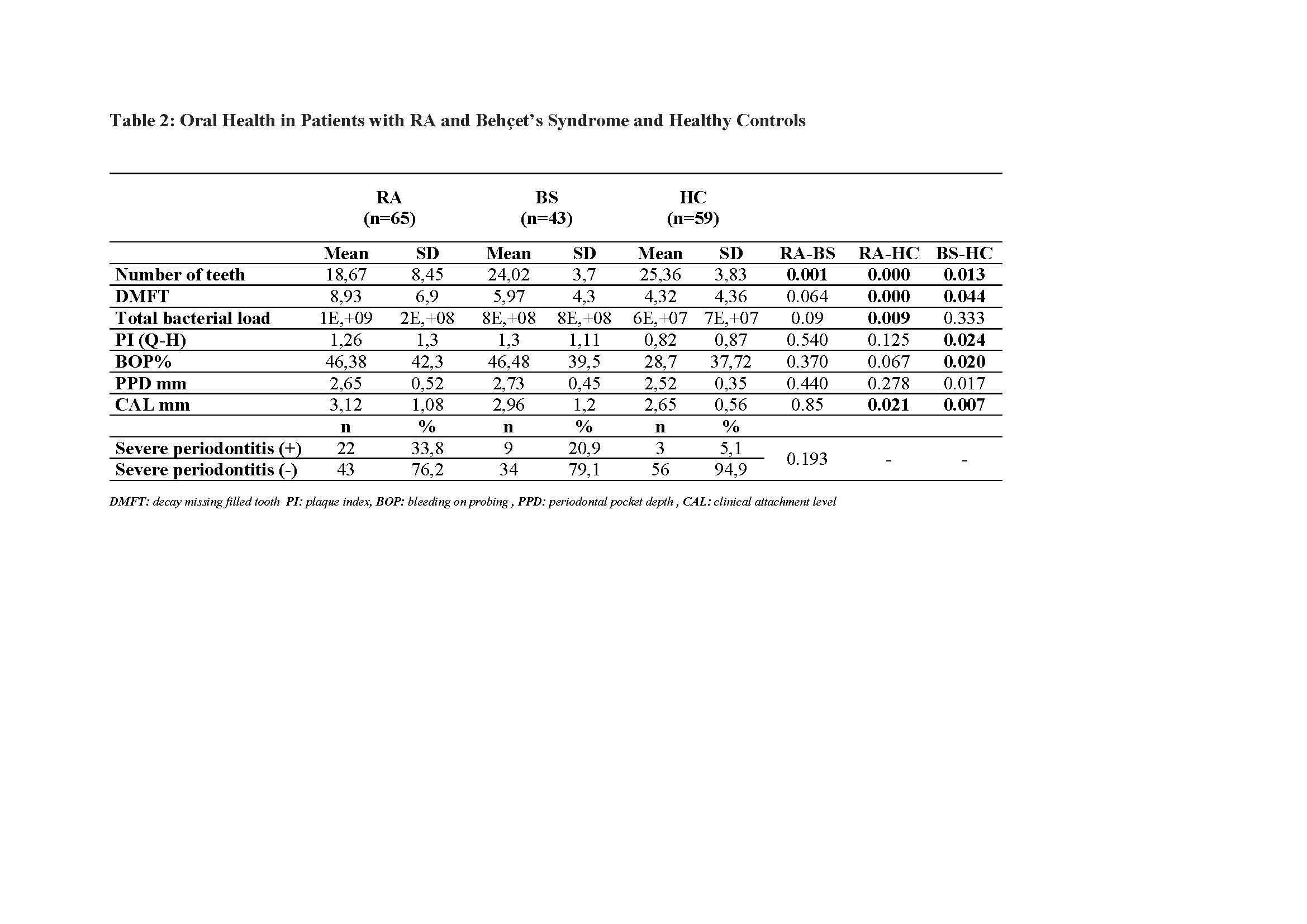Session Information
Session Type: Poster Session (Tuesday)
Session Time: 9:00AM-11:00AM
Background/Purpose: PGLYRP1, a member of peptidoglycan recognition proteins is a putative ligand as a ligand for triggering receptor expressed on myeloid cells-1 (TREM-1) which is involved in amplifying pro-inflammatory processes in chronic inflammatory diseases. However, the presence of circulating PGLYRP1 in patients with rheumatoid arthritis (RA) who suffer from periodontal disease is currently unknown.
The aim of the study was to investigate the association of circulating TREM-1 and its ligand PGLYRP1 with oral inflammatory/infection burden among patients with rheumatoid arthritis (RA).
Methods: The study population was recruited among individuals diagnosed with RA who were under sDMARD treatment for more than 6 months and never used biologic treatment (n=65, (F/M: 45/17) at the Department of Rheumatology, Faculty of Medicine, Marmara University, Turkey. 43 patients with Behcet syndrome (BS, F/M: 31/12) and 59 systemically healthy subjects (HC, F/M: 40/19) were assessed as controls. Serum and saliva samples were collected on the same day of oral health and musculoskeletal examination. RA disease activity was assessed using 28- joint disease activity score (DAS-28). Oral health was evaluated by dental and periodontal indices. Salivary levels of cumulative bacterial load and individual species including S.oralis, A.oris, F.nucleatum, P.intermedia, A.actinomycetemcomitans, T.denticola, P.gingivalis, and T.forsthia were analyzed by quantitative real-time polymerase chain reaction (qPCR). sTREM-1 and PGLYRP1 levels in serum were analyzed by ELISA.
Results: Elevated sTREM-1 and PGLYRP1 levels in serum was observed in RA (167,1±95,0 pg/ml; 157,5±228,8 pg/ml) than BD (102,8±44,4 pg/ml; 52,4±26,01pg/ml) and HC (90,7±56,5 pg/ml; 68,8±37,7 pg/ml) (p< 0.05)(Table 1). RA patients presented with significantly higher total bacterial load (p< 0.05) compared to the HC group. Tooth loss was significantly higher in RA (18.67±8.45) compared to those of BD (24.02±3.7) and HC (25.36±3.83)(p=0.001 and p=0.000) (Table 2). In RA, sTREM-1 and PGLYRP1 levels were significantly higher in patients with severe periodontitis (219,1±107,9 pg/ml and 265,6±336,7 pg/ml) than the others (133,9±68,9 and 87,1±55,3 pg/ml) (p=0.006; p=0.01, respectively) (Table 3).
Conclusion: Serum sTREM-1 and its ligand PGLYRP1 levels were higher in patients with RA than BD and HC and especially were higher in patients with severe periodontitis. In addition, increased tooth loss and higher total bacterial load were associated with RA.

ACR-2019-DRAFT_NB Nİ -table 1-pdf-

ACR-2019-DRAFT_NB Nİ -table 2 PDF-

ACR-2019-DRAFT_NB Nİ -table 3 PDF-
To cite this abstract in AMA style:
Inanc N, MUMCU G, Can M, Direskeneli H, Bostanci N. Periodontal Pockets as a Potential Source of Circulating TREM-1 and Its Ligand PGLYRP1 in Patients with Rheumatoid Arthritis [abstract]. Arthritis Rheumatol. 2019; 71 (suppl 10). https://acrabstracts.org/abstract/periodontal-pockets-as-a-potential-source-of-circulating-trem-1-and-its-ligand-pglyrp1-in-patients-with-rheumatoid-arthritis/. Accessed .« Back to 2019 ACR/ARP Annual Meeting
ACR Meeting Abstracts - https://acrabstracts.org/abstract/periodontal-pockets-as-a-potential-source-of-circulating-trem-1-and-its-ligand-pglyrp1-in-patients-with-rheumatoid-arthritis/
